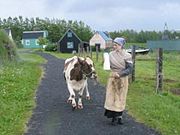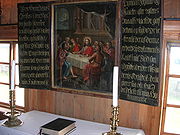
Árbæjarsafn
Encyclopedia

Árbæjarsafn is the historical museum
Museum
A museum is an institution that cares for a collection of artifacts and other objects of scientific, artistic, cultural, or historical importance and makes them available for public viewing through exhibits that may be permanent or temporary. Most large museums are located in major cities...
of the city of Reykjavík
Reykjavík
Reykjavík is the capital and largest city in Iceland.Its latitude at 64°08' N makes it the world's northernmost capital of a sovereign state. It is located in southwestern Iceland, on the southern shore of Faxaflói Bay...
as well as an open air museum and a regional museum. Its purpose is to give the public an insight into the living conditions, work and recreational activities of the people of Reykjavík in earlier times.
History


In 1954, the Reykjavík Archives and Historical Collection were officially founded and Lárus Sigurbjörnsson was hired as director, and he set about collecting artefacts of many kinds.
Things now moved quickly. The old farm Árbær, which had long been a popular rest stop and inn for people on the way to and from Reykjavík, had been abandoned and the farm buildings were in poor condition due to weathering and vandalism. In 1957, the city council agreed that a public park and open air museum with old houses of historical value should be created there. It was opened in August of that year.
Árbæjarsafn was first conceived as a department of the Archives and Historical Collection of Reykjavík, an open air museum where the living environment of past generations could be re-created in an authentic manner. In 1968, the Reykjavík Historical Museum and the Árbæjarsafn were consolidated under the name Árbær Museum. In the same year, the city council decided to create the office of municipal curator. The first holder was Nanna Hermansson (1974-1984), followed by Ragnheiður Þórarinsdóttir (1984-1989), Margrét Hallgrímsdóttir (1989-2000) and the current office holder Guðný Gerður Gunnarsdóttir (2000-).
When the museum was founded in 1957, it was located a short distance outside the built-up areas of Reykjavík. Since then, the city has grown considerably, and now reaches far beyond the museum area.
In 2006 the museum opened a new exhibition in central Reykjavík, based on archaeological findings. That exhibition is called Reykjavík 871±2
Reykjavík 871±2
Reykjavík 871±2 is an exhibition on the settlement of Reykjavík, Iceland, created by the Reykjavik City Museum . The exhibition is based on the archaeological excavation of the ruin of one of the first houses in Iceland and findings from other excavations in the city centre...
.
The museum was awarded the Icelandic Museum award for the year 2006.
Houses



- LaugavegurLaugavegurThe Laugavegur is a famous trekking route in South-West Iceland from the hot springs area of Landmannalaugar to the glacial valley of Þórsmörk. It is noted for the wide variety of landscapes that are experienced in just . The route is typically completed over 2–4 days with potential stops at the...
62: the ticket office, a former shop on Reykjavík's most famous shopping street. - Professor'sProfessorA professor is a scholarly teacher; the precise meaning of the term varies by country. Literally, professor derives from Latin as a "person who professes" being usually an expert in arts or sciences; a teacher of high rank...
house, which houses the museum offices. Originally built as residence for the Chief Medical Officer at Kleppur mental hospital. - Landakot (or ÍR-House): built in 1897 as the first Catholic church since the ReformationProtestant ReformationThe Protestant Reformation was a 16th-century split within Western Christianity initiated by Martin Luther, John Calvin and other early Protestants. The efforts of the self-described "reformers", who objected to the doctrines, rituals and ecclesiastical structure of the Roman Catholic Church, led...
. Was later used as a gym. - Laufásvegur: donated by the British Embassy in the 1960s. Currently the residence of the museum custodian and their family.
- Suðurgata 7: originally located in the city centre, now houseing three exhibitions: the home of a wealthy family around 1910, a jeweller's workshop and an exhibition on women's clothing.
- Lækjargata 4: currently houses the museum General Store as well as an exhibition on the history of Reykjavík.
- Líkn (Relief): used for administrative purposes.
- StableStableA stable is a building in which livestock, especially horses, are kept. It most commonly means a building that is divided into separate stalls for individual animals...
: a typical stable from the city centre. - Efstibær: a labourer's cottageCottage__toc__In modern usage, a cottage is usually a modest, often cozy dwelling, typically in a rural or semi-rural location. However there are cottage-style dwellings in cities, and in places such as Canada the term exists with no connotations of size at all...
from the 19th century. Currently housing an exhibition on the life of workers during the Great DepressionGreat DepressionThe Great Depression was a severe worldwide economic depression in the decade preceding World War II. The timing of the Great Depression varied across nations, but in most countries it started in about 1929 and lasted until the late 1930s or early 1940s...
. - Dillon's House: the museum coffee shopCaféA café , also spelled cafe, in most countries refers to an establishment which focuses on serving coffee, like an American coffeehouse. In the United States, it may refer to an informal restaurant, offering a range of hot meals and made-to-order sandwiches...
. - Þingholtsstræti 9: a 19th century house, which currently houses an exhibition on the house's original residents.
- Blacksmith'sBlacksmithA blacksmith is a person who creates objects from wrought iron or steel by forging the metal; that is, by using tools to hammer, bend, and cut...
house: a blacksmith's house - Hábær: a half stone house, originally home to 19th century landless labourers.
- Nýlenda: also a half stone house.
- Miðhús: a late 19th century home of landless labourers.
- Reykhólar: home to the museum's assistant custodian.
- GoldGoldGold is a chemical element with the symbol Au and an atomic number of 79. Gold is a dense, soft, shiny, malleable and ductile metal. Pure gold has a bright yellow color and luster traditionally considered attractive, which it maintains without oxidizing in air or water. Chemically, gold is a...
Drill: originally used to search for gold, but later used to drill for hot water. - Nissen hutNissen hutA Nissen hut is a prefabricated steel structure made from a half-cylindrical skin of corrugated steel, a variant of which was used extensively during World War II.-Description:...
: a World War IIWorld War IIWorld War II, or the Second World War , was a global conflict lasting from 1939 to 1945, involving most of the world's nations—including all of the great powers—eventually forming two opposing military alliances: the Allies and the Axis...
Nissen hut, used for storage. - Ívarssel: originally home to a well known fishing boat captain. Awaiting restoration.
- SlaughterhouseSlaughterhouseA slaughterhouse or abattoir is a facility where animals are killed for consumption as food products.Approximately 45-50% of the animal can be turned into edible products...
: an early 19th century warehouseWarehouseA warehouse is a commercial building for storage of goods. Warehouses are used by manufacturers, importers, exporters, wholesalers, transport businesses, customs, etc. They are usually large plain buildings in industrial areas of cities and towns. They usually have loading docks to load and unload...
, now houses an exhibition on building techniques in Reykjavík in the period 1840-1940. - GranaryGranaryA granary is a storehouse for threshed grain or animal feed. In ancient or primitive granaries, pottery is the most common use of storage in these buildings. Granaries are often built above the ground to keep the stored food away from mice and other animals.-Early origins:From ancient times grain...
: also a 19th century warehouse. Now houses an exhibition on DiscoDiscoDisco is a genre of dance music. Disco acts charted high during the mid-1970s, and the genre's popularity peaked during the late 1970s. It had its roots in clubs that catered to African American, gay, psychedelic, and other communities in New York City and Philadelphia during the late 1960s and...
and PunkPunk rockPunk rock is a rock music genre that developed between 1974 and 1976 in the United States, the United Kingdom, and Australia. Rooted in garage rock and other forms of what is now known as protopunk music, punk rock bands eschewed perceived excesses of mainstream 1970s rock...
in IcelandIcelandIceland , described as the Republic of Iceland, is a Nordic and European island country in the North Atlantic Ocean, on the Mid-Atlantic Ridge. Iceland also refers to the main island of the country, which contains almost all the population and almost all the land area. The country has a population...
in the period 1975-1985. - Aðalbjörg RE: a fishing boat. Not open to the public.
- Árbær FarmFarmA farm is an area of land, or, for aquaculture, lake, river or sea, including various structures, devoted primarily to the practice of producing and managing food , fibres and, increasingly, fuel. It is the basic production facility in food production. Farms may be owned and operated by a single...
: the only one of the museum's houses still standing on its original spot. - SmithyForgeA forge is a hearth used for forging. The term "forge" can also refer to the workplace of a smith or a blacksmith, although the term smithy is then more commonly used.The basic smithy contains a forge, also known as a hearth, for heating metals...
: a 1960s replica of a smithy. - Church: the museum church comes from the North of Iceland. It is consecrated and is rented out for various services.
- VestryVestryA vestry is a room in or attached to a church or synagogue in which the vestments, vessels, records, etc., are kept , and in which the clergy and choir robe or don their vestments for divine service....
: built in the 1960s to provide room for a priest and other people using the church. - Boy ScoutBoy ScoutA Scout is a boy or a girl, usually 11 to 18 years of age, participating in the worldwide Scouting movement. Because of the large age and development span, many Scouting associations have split this age group into a junior and a senior section...
hut: the first Boy Scout cabin built in Iceland.
Opening hours

The gift shop and other facilities are not usually open during the winter season; however, the museum office and library may often be accessed out-of-season. Visitors arriving early for the 1300 hours guided tour may even be invited to wait in the library.
Although the site is a little way out of the city centre, there is a very good bus service to the museum, operating at roughly half-hour intervals, with a bus stop immediately outside the main entrance.
Further information
City Museum homepageSources
- Árbæjarsafn guidebook

